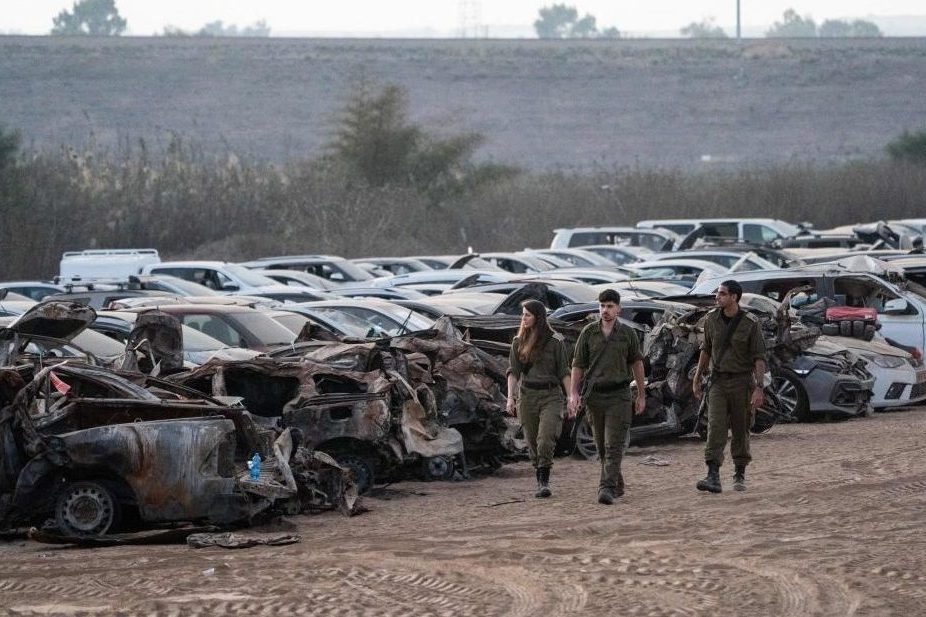The rise of the combat drone is changing the nature of the battlefield, as Israel has already found to its cost. The October 7 atrocity began when dozens of cheap commercial drones equipped with explosives paralyzed the Israeli army’s communications and camera systems surrounding the Gaza border.
It was the first crucial phase in an intricately planned terrorist attack which would end hours later with more than 1,500 Israeli deaths and a nation traumatized.
Imagery released later by Hamas on social media showed small drones exploding on communications towers and on army lookout posts. The Israeli Defense Forces — one of the world’s most battle-ready armies, which prides itself on its ability to defend the country against all enemies — was caught cold.
The use of drones is the latest development in the concept known as asymmetric warfare, a term which came into general use after 9/11.
Put simply, asymmetric warfare is seen when military capabilities between adversaries are so significantly different that they cannot make the same sort of attacks on each other. The drone — or more accurately, the use of commercial drones adapted for combat — is allowing militarily inferior forces, such as Hamas, to punch above their weight.
Combat drones have been around for at least twenty years and were once the preserve of the world’s richest nations. The US air force’s expensively made Predator and later more advanced Reaper drones were designed during the war on terror for attacks on high profile targets, as well as providing close support to combat troops.
Armed with 500 lb satellite guided bombs and Hellfire anti-tank missiles, Reapers could loiter unseen and unheard at 20,000 ft for hours on end, waiting for a target to appear. The notorious butcher Jihadi John was one notable victim when he was killed in a US drone missile strike in Raqqa, Syria in November 2015.
Back then the Reaper was one of the most fearsome and sophisticated weapon systems on the planet. The aircraft were “flown” by pilots often thousands of miles away from the battlefield, in places like Creech US Air Force Base in Nevada, a forty-five-minute drive from Las Vegas.
But times have changed. Drone warfare is almost like a start-up industry, where cheap commercial mass-produced drones are being adapted to become killing machines. Chilling footage released by Hamas on Thursday appears to show that the terrorist group is taking advantage of these technological advances — as well as adopting drone tactics used in the Ukrainian war.
The short video released on social media showed a drone flying over the bomb-ravaged wasteland which was once the Beit Hanoun neighborhood of northern Gaza hunting for a target. In footage reminiscent of that seen in Ukraine, a small black explosive dangles mid-air for a few seconds and then drops onto what appears to be Israeli soldiers resting below. The bomb takes a few seconds before it hits the ground and explodes. The soldiers run for cover while others, presumably dead or wounded, remain motionless on the floor. Tragically, the video footage demonstrates the nature of urban warfare. Even after the Israeli army has captured or cleared a large area of ground, their troops in the open may still be vulnerable to a drone attack.
Liran Antebi, a drone technology expert at the Institute for National Security Studies (INSS) in Tel Aviv told Deutsche Welle, that she was “surprised by the unexpected and complex use of Hamas drones.” She added: “this proves that, even if they are technologically quite primitive, they can be much deadlier in a complex mission than we previously would have admitted. It’s hard to create an overall solution to the threat of drones and certainly not a hermetic solution.”
On Thursday, the Israeli military confirmed fifteen soldiers had been killed in battles in northern Gaza since Tuesday — the first Israeli casualties inside the enclave. It did not mention the purported drone bombing.
If Hamas uses drones this way, it will not defeat the Israeli Defense Forces directly. But it has the potential to undermine morale and cause real fear, in the same way the Taliban used improvised explosive devices in Afghanistan. The lesson from that war showed that the poorly equipped Taliban did not have to defeat US forces on the battlefield. Instead all the Taliban needed to do was cause enough casualties to undermine support for the war in Washington. Hamas may attempt to do the same with drones.
This article was originally published on The Spectator’s UK website.


























Leave a Reply